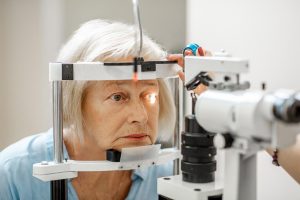A virtual reality program helped hoarders clear out their clutter, researchers report.
Hoarding disorder, which strikes more than 2.5% of Americans, has only been defined as a mental health condition for 10 years, and it’s both debilitating and hard to treat.
So, researchers at Stanford Medicine recently conducted a small pilot study to see if a newer technology — virtual reality — could help patients practice the steps they would need to take to manage their condition.
In the tiny study, a majority of the patients — 7 of 9 — reported an average decrease in symptoms of about 25%. In addition, 8 of the 9 participants had less clutter in their homes after the sessions, with an average decrease of 15%.
“Part of what is important in translating the promise of virtual reality into the real world is these small proof-of-concept studies to say, ‘Is it feasible? Are participants going to be able to engage with the technology?’ And that wasn’t immediately evident that it would in this population, so having the data was really important,” explained senior study author Dr. Carolyn Rodriguez. She is a professor of psychiatry and behavioral sciences at Stanford Medicine in California.
Among the reasons why it was uncertain whether virtual reality (VR) would work for patients is that many people with hoarding disorder are older and may not be comfortable using VR technology.
Hoarding disorder can lead to accumulation of clutter that impairs a person’s safety, relationships and ability to work. Stigma and shame can prevent people from seeking help.
The condition appears to have a hereditary component, but genetics are not the only contributor. Severity appears to increase with each decade, Rodriguez said.
One of the main treatments is cognitive behavioral therapy, with in-person practice on decluttering, but that can sometimes be unsafe for the clinician.
“We wanted to be able to capture the usefulness of the practice, but without any of the safety concerns,” Rodriguez said.
For this study, researchers worked with nine people over the age of 55. Each person took photos and videos of the most-cluttered areas of their homes and of 30 specific possessions.
Stanford University engineering students and a VR company also got involved, creating custom 3D virtual environments.
Then participants used VR headsets and handheld controllers to navigate through the scenes of their room.
They also attended 16 weeks of group therapy that provided peer support and behavioral skills related to hoarding.
The participants received the VR headsets with one-hour sessions guided by a clinician in weeks seven to 14. The individuals practiced placing possessions in recycling, donation or trash bins. They were then assigned the task of discarding the actual item at home.
One of the exciting discoveries was that the VR environment can separate the objects being collected with some of the other factors that attach people to them, Rodriguez said.
“You can’t actually touch it. You can’t actually have the olfactory cues of a loved one or the experience you had with it. And so it gives people a little bit of space,” Rodriguez said.
“It’s more of a kind of stepping stone to be able to, in a less evocative situation, be able to think through some of the decision-making skills, and not be driven so much by that strong, strong attachment,” she added.
In a virtual reality environment, you can also practice letting go of something over and over again.
“In that way, you’re building your [emotional] muscle, to be able to make these decisions,” Rodriguez said.
The successes of the patients in this study were comparable to what someone can achieve in group therapy alone, so it’s not clear what the impact of the VR will be.
Some of the patients also felt the VR therapy was unrealistic, which may suggest a need for more advanced technology.
The study, published in the October issue of the Journal of Psychiatric Research, was funded by the U.S. National Institutes of Health.
“These authors have shown us that the use of virtual reality is both feasible and well accepted by patients. That by itself is a pretty significant feat, given that people with hoarding disorder can often be very difficult to treat,” said David Tolin, director of the Anxiety Disorders Center at The Institute of Living in Connecticut. Tolin was not involved in the VR research.
Still, “we need to be cautious and recognize that this study does not tell us whether or not virtual reality works in the treatment of hoarding disorder. In order to do that, you need a control group, but I eagerly await that research,” Tolin added.
People with hoarding disorder very often suffer from low motivation to do anything about their situation, Tolin said, which may make them resistant to starting treatment or following through on it.
“In our research, we see there’s a very direct link between how engaged the patient is and how well they do in the therapy,” Tolin noted.
In his lab at University of Southern California, Albert Rizzo has for decades been doing a variety of work related to mental health and virtual reality, including developing applications for treating post-traumatic stress disorder (PTSD).
Since it might induce more anxiety for someone to engage in exposure therapy in person, some will be open to virtual reality, Rizzo said.
Even though the brain knows this is a simulation, it still reacts emotionally as if it’s real.
“And through that practice over time, you may build the brain’s predisposition to be able to do it in reality,” Rizzo said.
Rizzo said the biggest challenge he sees in this study is the need for customization of VR simulation for each user. But even the process of taking these photos and videos of patients’ homes could be part of the therapeutic process, he noted.
“They’re constructing their own world in a way that I think facilitates the therapeutic process,” Rizzo said. “It’s still going to be very labor-intensive.”
More information
The International OCD Foundation has more on hoarding disorder.
SOURCES: Carolyn Rodriguez, MD, PhD, associate dean, academic affairs, Stanford University School of Medicine, and consultation-liaison psychiatrist, Palo Alto Veterans Affairs, Calif.; David Tolin, PhD, director, Anxiety Disorders Center, The Institute of Living, and adjunct professor, psychiatry, Yale University School of Medicine, New Haven, Conn.; Albert Rizzo, PhD, associate director, Institute for Creative Technologies, and research professor, psychiatry and gerontology, University of Southern California, Los Angeles; Journal of Psychiatric Research, October 2023
Copyright © 2024 HealthDay. All rights reserved.















-300x169.jpg)









